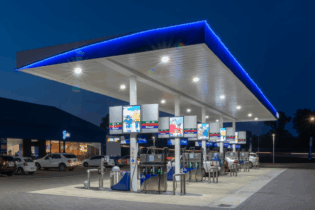As a vehicle travels down a road, there are a number of factors that contribute to the amount of fuel it will use in getting from point A to point B. The main parameters are vehicle weight, aerodynamic drag, mechanical losses and tyre rolling resistance.
Although tyres are just one of these factors, they can affect up to a third of the vehicle’s total fuel consumption. As each tyre on a vehicle rolls down the road, it creates a drag force. It is composed of the energy loss created by the deflections of the tyre sidewall and the movements, compression and deformation of the tyre tread in the footprint at the road’s surface. This drag force is called rolling resistance and can be measured very accurately in a laboratory. Aerodynamics and speedA vehicle’s aerodynamics and its travelling speed have an extremely large effect on how much fuel is consumed. The force created by the aerodynamic drag of a vehicle increases exponentially with the speed of the vehicle. Tyre rolling resistance increases linearly with speed, but tyres are a proportionally smaller percentage of the total drag on a vehicle as the speed increases. Other factors
Ambient air temperature, weather conditions, road surfaces (sand, gravel, asphalt, concrete) and terrain (flat, hilly or mountainous) are environmental factors that are impossible to control but have a direct effect on fuel consumption. Vehicle configuration
On a typical 40 t, 5 axle truck, each axle contributes to a portion of the total vehicle tyre rolling resistance. Drive and trailer axles combined contribute about 83% of the total tyre rolling resistance. To minimise the vehicle’s fuel consumption, it is recommended to equip all axles with low rolling resistance, fuel-efficient tyres. The contribution of tyres to the total energy required to move a vehicle down the road is dependent on the effects of many outside factors, which include: Tyre inflation
Tyre rolling resistance is heavily dependent on inflation pressure. A 1 bar deviation from the nominal inflation pressure could lead to a 5% difference in rolling resistance, which may result in significant fuel cost increase (see example below). For optimum rolling resistance, it is important to have the tyres inflated correctly, as recommended for the respective axle loads. In addition, under-inflation may have negative effects on tyre durability. Fuel difference per truck based on: 150 000 km/year – €1 (R10.86)/ℓ – 35 ℓ/100 km Wheel alignment
Incorrect vehicle alignment may drastically influence rolling resistance and consequently fuel consumption. If any of the wheels on a 12-wheel tractor and trailer are not properly aligned, the total drag on the vehicle increases. There is greater ‘scrub’ of the tyres against the road surface and, potentially, greater aerodynamic drag when the tractor and trailer are not tracking parallel to the direction of travel. The example below of a 3-axle trailer shows that correct vehicle alignment helps to optimise fuel economy. Driving style
The driving habits or ‘style’ of the operator of a vehicle can have a very large influence on the amount of fuel consumed. Aggressive driving can wipe out many of the gains obtained from investments in fuel-efficient tyres and engines, aerodynamic devices or synthetic lubricants. However, today’s modern automated truck drivelines tend to reduce the effects that drivers can have on fuel economy while driving, further increasing the saving potential of adequate tyres. With today’s technology, it is possible to measure accurately the amount of fuel an engine uses over a period of time, allowing for programmes to be set up to reward drivers for good fuel efficiency.
Fuel efficient truck tyres
Goodyear’s modern truck and bus tyres are developed to provide optimum fuel efficiency. Most of the gains in fuel efficiency can be obtained from the crown area of the tyre (tread compound, tread design and/or the tread depth, belt package). The crown area contributes about 75% of the tyre rolling resistance, sidewall and bead areas for about 25%. This is also why using the optimum inflation pressure is very important: it makes the tread area deform just enough to carry the load and avoids unnecessary tread movement generating heat, and consequently rolling resistance.
In addition to the recommended use of specific ‘fuel-efficient’ tyres, here are a few general comments concerning factors affecting tyre rolling resistance: • Rib type tyres are better on rolling resistance than block type; this is mainly due to less movement of the tread in the contact patch area.
• Low aspect ratio tyres are stiffer, allowing for less flexing under load, so they typically have lower rolling resistance compared to high aspect ratio tyres.
• Worn tyres have less rolling resistance than new tyres: as a truck tyre wears down, the tread pattern stiffens, which leads to less flexing/deformation in the tread area. The use of fuel-efficient tyres on all axle positions can make a significant difference in fuel consumption. A reduction of 10% of rolling resistance on a complete vehicle results in approximately 3% reduced fuel consumption (approximately 0.9 ℓ/100 km on a vehicle that consumes 30 ℓ/100 km). 10% tyre rolling resistance decrease (all axles) = 3% fuel economy Example
A standard 40 t truck, with average fuel consumption of 30 ℓs/100 km, yearly mileage of 150 000 km, fuel price €1/ℓ, equipped with ‘standard’ tyres: Yearly fuel cost: 1 500 (100 km) x 30 ℓ/100 km x €1 = €45 000
The same truck equipped with ‘fuel-efficient’ tyres (10% reduced rolling resistance)
Yearly fuel cost: 1 500 (100 km) x 29.1 ℓ/100 km x €1 = €43 650
Potential saving: €1 350 per year per truck. Summary
We cannot influence road conditions, but the use of low rolling resistance, fuel-efficient tyres, in combination with good vehicle and tyre maintenance, as well as adequate driving style, allows fleets to minimise truck fuel consumption compared to with the use of ‘standard tyres’ on the same vehicles or same operations.
With today’s fluctuating fuel prices, as well as more and more restrictive emission legislations, fuel consumption is a major economical and ecological factor in transport operations. Goodyear’s modern, fuel-efficient truck and bus tyres provide an ideal option to:
• maximise fleet efficiency
• minimise cost per kilometre
• reduce CO2 emissions. Acknowledgements: Goodyear Tyre & Rubber Holdings (Pty) Ltd








